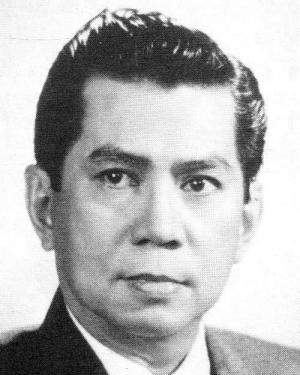Valera, Ramon O.
GS, HS 1931
DECEASED
2007
DLSAA Distinguished Lasallian Awardee
POSTHUMOUS
Before RAMON VALERA (HS '31) entered the local world of fashion designing during the prewar days, the leading dressmakers were women such as Pacita Longos, Purita Escurdia, Marina Antonia and Mina Roa. It all started when Ramon was still a high school senior at La Salle and he designed party dresses for his two kid sisters, Lulu and Didi. He first learned his craft in his parents' shop on Escolta, named Manila Fashions. By the time he was studying business administration at Far Eastern University, around 1935, he was already known as the most innovative male couturier in Manila. When the less than five-foot daughter of Secretary Jorge B. Vargas wanted a wedding terno dress in 1939, Valera realized that she would look stunted wearing the traditional panuelo or neckpiece, and a saya of foot-long skirt with stiff butterfly sleeves. So he designed a new terno without the panuelo, with detachable sleeves and a one-piece bodice with a zipper at the back. The new look shocked Manila's society women, but so entrancing and comfortable were his ternos that the innovation became popular and was soon copied by other dressmakers. For the next three decades Valera was the best known couturier in the Philippines. He was the only male dressmaker who could design, cut, baste and sew all by himself. He created his designs either directly in his head, or drew sketches to guide his four assistants. Usually, he cut the fabric himself while his aides hovered around for instructions. He would discard an already finished gown if it did not suit his taste, or if it did not come up to his fastidious standards. Every First Lady of the islands, from Aurora Aragon Quezon to Imelda Romualdez Marcos — with the exception of Eva Macapagal — owned three or four of his creations. As the fashion dictator of his generation he came out with the following observations: 1. Filipino women should keep the shade of their skin in mind. They should not wear mocha brown laced with black. 2. Champagne and white are good colors to wear. 3. Don't always follow what magazines say is the style. 4. Most women don't know what is best for them. Some are big and fat yet dare to wear peasant dresses with wide belts. [He did not like to design for fat women or for those with big busts.] 5. The mini skirt is for girls and small women. Valera charged the highest prices for his creations. As the late Lina Flor exclaimed in her column, "Nobody can equal Valera when he is inspired, and not anybody with a thick pocketbook can inspire him either." National Artist Nick Joaquin when he was still on the staff of the Philippines Free Press, gave Valera the ultimate accolade with these words: "As Proust is to French literature, so is Valera to Philippine fashion." Ramon never married. He was in love with a pretty girl, but when she suddenly died before their marriage, he decided to remain a bachelor and devote all his time and talent to designing beautiful dresses for women. He was the fashion designer of socialites, movie stars and fashion moders for the glittering balls of the annual Tiro al Blanco, the Bachelor's Club and the Kahirup, the enclave of super rich Visayan women. "While he lived, chic in Manila was really chic, and glamour meant more than a touch of class. It called for grandeur as well," noted another fashion columnist. In his 61st year in 1972 he suffered a fatal heart attack. But he had lived long enough to make his mark in the fashion world of the Philippines.





